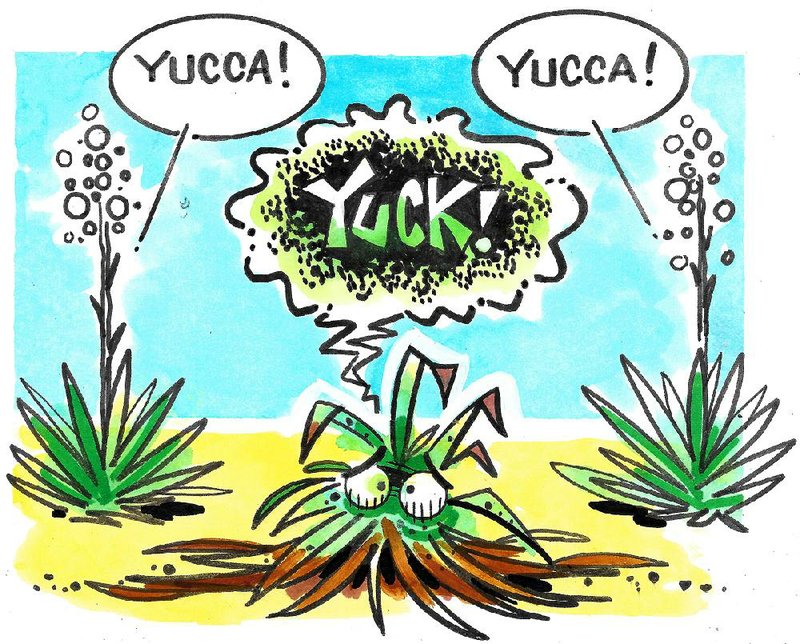Q I have some yucca plants that are about 8 or 9 years old. I took them out of a pile of dirt, rocks and trash pushed up with a dozer preparing ground for our house and yard. Some are tall enough that they're beginning to fall over. Should I cut them back? If so, in what season? How short? How long will it take them to produce blooms after they are cut back? Blooms are attacked by some insect each year. They destroy the blooms pretty quickly. One year I succeeded in avoiding most by spraying an insecticide when I noticed small black bugs. This picture [reader submitted photo] is my attempt to photograph that bug. I think the little black bug is the problem. Earlier I thought it was a larger bug that swarms the blooms before they begin to die. County agent told me the larger bugs are assassin bugs and I should leave them alone -- they're my friends. Do you have any suggestions to protect the blooms?
A Are they falling over because their roots aren't established enough, or because they are simply top heavy? Pruning them back may set back their blooming for a year or two as new rosettes form and mature enough to bloom. Typically they multiply quite rapidly. The small black insect could be an aphid, which can go after the blooms. Aphids can easily be controlled with insecticidal soap. If you are going to cut them back, do so as new growth is beginning in the spring. We are having a really cold winter so far, and cutting them back now would expose them too much. If the insects come back again, collect a few in a small jar and take them into your local extension office for proper identification.
Q Our long-term (previously healthy) elaeagnus lining our backyard appears to be dying. Many branches have simply turned dry and brown. We do have a sprinkler. Would you please advise?
A We had an exceptionally dry fall and early winter. That, coupled with the low temperatures and the length of those low temps, will lead to some plant damage. We won't know how much until plants begin to grow in the spring. We still have a bit of winter left to go. For now, just wait and see what happens for the rest of the winter. Assess them in the spring and see how they come out. Give them a chance to grow in the spring and then decide what to do with them.
Q Sometime after 1985, when we had bought our first house in North Little Rock you had a weekly Saturday call-in radio show on KARN. I called in the fall, after pruning my forsythia, which had sprawled beyond its welcome. You justifiably reprimanded me for pruning it into a shrub shape and doing so at the wrong time of the year. In that same show, a couple more callers chimed in on the same issue and you admonished them to "don't do what Joe did ..." I became the poster child for improper forsythia pruning! Now, I'm hoping you can help with my hydrangea question ... some 30-plus years later. With the necessary removal of an old, large maple tree this fall, we have turned a shady area in Northwest Arkansas into what will be a sunny one this spring. The two hydrangeas transplanted from my late mother-in-law's gardens 20 years ago had thrived in the old maple's shade with mottled sunlight. I know they will not survive the bright direct sun. We intend to move them to a mostly shady area on the north/northwest front of our house. Would it be advisable to transplant them just before they leaf out in the spring? Typically, we let them leaf out then remove any canes which don't leaf out. Instead, should we prune all the canes back severely prior to the transplant? Any additional advice you provide will be appreciated.
A It seems you are a reformed gardener now, Joe. I will say that big leaf hydrangea (Hydrangea macrophylla) is not a great choice anymore for Northwest Arkansas as it can be quite sensitive to low temperatures, especially as we near spring and they begin to break dormancy. If they do get frozen back, unless they are a re-blooming type, they will not flower that year. I would wait until mid-March and hope we are finished with cold weather, and then move them to their new location. Don't prune until they are fully leafed out and you can assess the damage. When I was in college studying horticulture, we were taught to remove one-third of the top growth when transplanting to compensate for root loss. Today, the theory is to leave as much top growth as possible to allow the plants to manufacture as much food as they can. Mulch the plants and water well all season to get them re-established. Good luck!
Janet B. Carson is a horticulture specialist for the University of Arkansas Cooperative Extension Service. Write to her at 2301 S. University Ave., Little Rock, Ark. 72204 or email her at
jcarson@arkansasonline.com
HomeStyle on 01/20/2018
